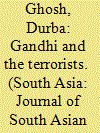|
|
|
Sort Order |
|
|
|
Items / Page
|
|
|
|
|
|
|
| Srl | Item |
| 1 |
ID:
189243


|
|
|
|
|
| Summary/Abstract |
What is the relationship between revolution and terrorism? Much of the time, terrorism and revolution are taken to be distinct forms of political contention. This article argues that, to the contrary, their relationship is much closer than is often imagined. We show that a range of contemporary terrorist groups contain revolutionary elements: they seek to capture and hold territory, and see themselves as part of movements where the goal is to transform international as well as domestic orders. This provides two points of distinction: first, between ‘order-maintaining’ and ‘order-transforming’ goals; and second, between ‘minimalist’ and ‘maximalist’ tactics. The result is a taxonomy of different types of ‘revolutionary terrorism’. This analytic is used to dig deeper into the parameters of revolutionary terrorism, using militant Salafism as an example of a maximalist, order-transforming movement. A focus on transnational, order-transforming revolutionary terrorism generates a range of insights into the violent strategies, international dynamics and organizational forms used by Islamic State, al-Qaeda and related groups. The resulting research agenda, the article concludes, is rich in possibilities.
|
|
|
|
|
|
|
|
|
|
|
|
|
|
|
|
| 2 |
ID:
147201


|
|
|
|
|
| Summary/Abstract |
Known for his advocacy of non-violence as a political strategy, this essay examines Gandhi's prolonged debates with revolutionary terrorists about the efficacy of non-violence. Over the course of three decades, Gandhi attempted to bridge the divide between non-violence and violent resistance, and recognised those who espoused political violence as embodying a shared sense of sacrifice and suffering; those who were jailed or detained for their crimes actively debated these strategies with him, even if they did not wholly agree about the efficacy of non-violence. The first two sections focus on Gandhi's engagements with the lives of two revolutionary terrorists who died as a result of their actions, Madanlal Dhingra and Gopinath Saha. The final section examines how two women revolutionary terrorists, Bina Das and Kamala Dasgupta, engaged with Gandhi and eventually joined his non-violent movement.
|
|
|
|
|
|
|
|
|
|
|
|
|
|
|
|
| 3 |
ID:
090919


|
|
|
|
|
| Publication |
2009.
|
| Summary/Abstract |
This article presents a cross-country comparison of the intensity of revolutionary terrorism in the developed world after the wave of mobilization in the late 1960s and early 1970s. Some countries were hit much more severely than others by this type of violence. The article tries to account for this variation with a new dataset of fatalities in 23 countries, for the period 1970-2000, based on local sources in six different languages. This dataset corrects in part the problems of underreporting that Jan Oskar Engene's TWEED dataset suffers from. The dependent variable is a novel index of the intensity of terrorism that combines the number of fatalities and the number of years in which the terrorist organization has killed people. The unit of analysis is the country in the whole period. Six broad hypotheses about the influence of economic development, social change, mobilization, welfare provision, population and political factors are tested in the article. The statistical results show that three variables are almost sufficient to explain variance: past dictatorship, high population and strong communist parties. Given that past dictatorship is the most important variable, three different mechanisms by which to understand its effect are suggested: the role of repression in countries with past political instability; dictatorship as a proxy for polarization; and past breakdowns as an indicator of the chances of overthrowing the system.
|
|
|
|
|
|
|
|
|
|
|
|
|
|
|
|
|
|
|
|
|